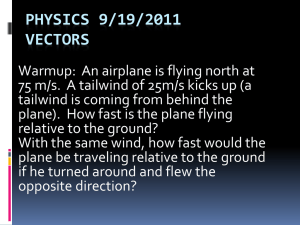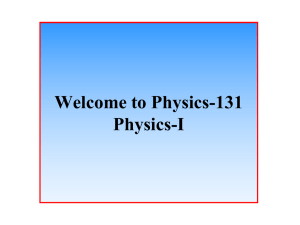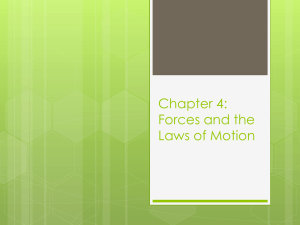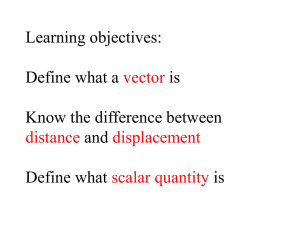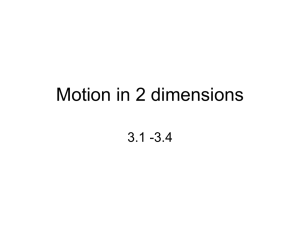Vectors PPT - Binghamton City School District
advertisement
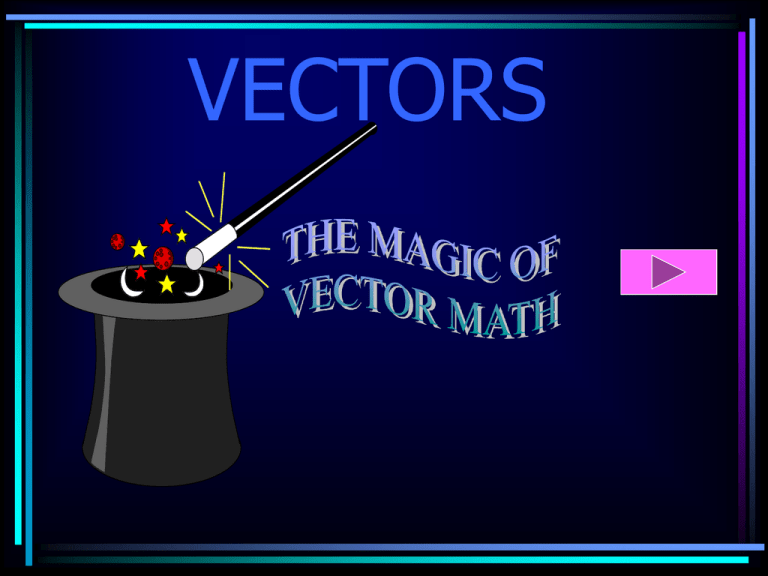
VECTORS 1. Scalars • Just a Value • This Value is called a Magnitude 2. Vectors VECTORS • Quantities that have MAGNITUDE (size or value) AND DIRECTION REPRESENTATION OF VECTOR QUANTITIES • VECTORS ARE REPRESENTED BY AN ARROW •tip •tail •THE ARROW: LENGTH = • THE MAGNITUDE OR SIZE OF THE VECTOR THE ARROW’S DIRECTION = • IS THE DIRECTION OF THE VECTOR EXAMPLES OF VECTORS • • • • • • • FORCE (a push or a pull) ELECTRIC/MAGNETIC FIELD STRENGTH ACCELERATION TORQUE – twist causing rotation DISPLACEMENT – not distance MOMENTUM – possessed by moving mass VELOCITY – not speed EXAMPLES OF SCALARS • • • • • Mass Time Distance Energy + Everything else that’s not a vector….. These quantities have “NO DIRECTION” • Take care here • You Can NOT Add them like regular numbers (called Scalars) VECTOR ADDITION (THE TIP-TO-TAIL METHOD) FINDING THE RESULTANT A B –The SUM or RESULT of Adding 2 Vectors is called VECTOR ADDITION (THE TIP-TO-TAIL METHOD) FINDING THE RESULTANT A B A B A B REVIEWING VECTOR ADDITION • ADD VECTORS IN ANY ORDER (A+B = B+A) • IF VECTORS ARE POINTING IN THE SAME DIRECTION THIS IS REGULAR ALGABRAIC ADDITION REVIEWING VECTOR ADDITION • POSITION THE TAIL OF ONE VECTOR TO THE TIP OF THE OTHER • CONNECT FROM THE TAIL OF THE 1ST VECTOR TO THE TIP OF THE LAST – THIS IS THE RESULTANT ADDITION CONTINUED A B A B MORE VECTOR ADDITION • SUPPOSE THE VECTORS FORM A RIGHT ANGLE • GRAPHICAL SOLUTIONS CAN ALWAYS BE USED BUT… – HERE IS A MATHEMATICAL SOLUTION…. – THIS SOLUTION USES THE PYTHAGOREAN THEORUM… C2 = A2 + B2 B = 3 lbs ADDING VECTORS THAT ARE AT RIGHT ANGLES TO EACH OTHER… R2 = 16 + 9 = 25 R = 5 lbs A = 4 lbs R2 = A2 + B2 R2 = 42 + 32 BUT R = 5 lbs IS ONLY HALF AN ANSWER!! WHY????? REMEMBER !!! •VECTORS HAVE 2 PARTS MAGNITUDE AND DIRECTION !!! HERE’S HOW TO FIND THE DIRECTION TRIG FUNCTIONS TO REMEMBER A = 4 lbs B = 3 lbs TRIG CALCULATIONS COS() = 4/5=0.8 SIN() = 3/5= 0.6 •USE YOUR CALCULATOR TO FIND THE ANGLE THAT HAS THESE VALUES OF SIN OR COS. Could also use TAN AT LAST THE ANGLE (THE VECTOR’S DIRECTION) SIN(X) = 0.6 ANGLE (X) = 37 DEGREES COS(X) = 0.8 ANGLE (X) = 37 DEGREES SO, THE OTHER HALF OF OUR ANSWER IS….. RESULTANT……. = 37 deg A = 4 lbs B = 3 lbs 5 lbs 37 degrees NORTH OF EAST •Not NORTHEAST i.e. NE is 45 deg SUMMARY •A VECTOR IS A DIRECTED QUANTITY THAT HAS BOTH A MAGNITUDE AND DIRECTION • IF THE ANGLE BETWEEN THE VECTORS IS • 0 deg: algebraic addition (MAXIMUM ANS.) • 180 deg: algebraic “subtraction” (MINIMUM ANS.) • 90 deg: use Pythagorean Theorem to find magnitude and trig functions to find the angle • COULD YOU PASS A QUIZ ON THIS MATERIAL???? RETURN TO BEGINNING • NOW? • LATER, WITH STUDY? CONTINUE TO VECTOR MATH Vector Concepts used in Physics – Fancy Foot Work • Imagine you were asked to mark your starting place and walk 3 meters North, followed by two meters East. Could you answer the following: – How far did you walk? – Where are you relative to your original spot? Fancy Foot Work • How far did you walk? – This requires a MAGNITUDE ONLY • SCALAR QUANTITY called DISTANCE • 3m + 2m = 5m • Where are you relative to your original spot? – This requires both a MAGNITUDE & DIRECTION • VECTOR QUANTITY called DISPLACEMENT Fancy Foot Work • Where are you relative to your original spot? – This requires both a MAGNITUDE & DIRECTION • VECTOR QUANTITY called DISPLACEMENT 2m, E End 3m, N Displacement: Needs Magnitude & Direction Start N W E Fancy Foot Work • Magnitude =? S 2m, E • The Length of the Hypotenuse s2=(3m)2 + (2m)2 3m, N Displacement = s s= 13 m 3.6m • Direction = East of North • Pick your Trig function D 3.6 m, 33.7o E of N • =33.7o, E of N Fancy Foot Work NOW, measure the angle from the +X axis…… 2m, E 3m, N Displacement = s = =33.7 = 90 – 33.7 = 56.3o 3 .6 m s 3.6m, 560 Multiplying a Vector by a Scalar • When you multiply a vector by a scalar, it only affects the MAGNITUDE of the vector ** Not the direction** • Example: o A 20m,45 o 3A 60m,45 o 5 A 100m,45 Vector Components • Component means “part” • A vector can be composed of many parts known as components • It’s best to break a vector down into TWO perpendicular components. WHY? – To use Right Triangle Trig Vector Components • Introducing Vector V • Vector V’s X-Component is its Projection onto the X-axis • Vector V’s Y-Component is its Projection onto the Y-axis V Sub Scripts in Action Now we have a Right Triangle Vy Vx Vector Components • Given this diagram, find V’s X & Y Components V =38.66o Vx= 5 Vy= 4 What’s the Magnitude of Vector V? 2 2 V 5 4 V 41 Vector Components • Now, knowing the magnitude of vector V, verify the V’s X & Y components using Trig Vx=? 41 Vy=? Vy 38.66o Vx Vx 41(Cos(38.66)) 5 Vy 41(Sin(38.66)) 4 Vector Components • Golden Rules of Vector Components – 1. If you know the magnitude and direction of vector V to be (V,), then you can find Vx & Vy by • Vx=Vcos • Vy=Vsin – 2. If Vx & Vy are known, the magnitude of the vector can be found with Pythagorean Theorem: V Vx Vy 2 2 WHAT ARE THE X & Y COMPONENTS OF VECTOR ‘A’? THESE ARE The VECTOR COMPONENTS OF A Sin OPP/HYP Sin Ay/A Ay = Asin Ax Cos ADJ/HYP Cos Ax/A Ax = Acos Ay A Ay =Asin Ax =Acos AN EXAMPLE • Suppose the magnitude of A = 5 and 37 deg. Find the VALUES of the X & Y components. Ay =37 Ay =Asin 5sin337 5(0.6) Ax =Acos 5(0.8) 5cos37 4 QUESTION #1 A couple on vacation are about to go sight-seeing in a city where the city blocks are all squares. They start out at their hotel and tour the city by walking as follows: 1 block East; 2 blocks North; 3 blocks East; 3 blocks South; 2 blocks West;1 block South; 6 blocks East; 8 blocks North; 8 blocks West. WHAT IS THEIR DISPLACEMENT? (i.e., WHERE ARE THEY FROM THEIR HOTEL)? ANSWER #1: USING GRAPH PAPER 1 block East; 2 blocks North; 3 blocks East; 3 blocks South; 2 blocks West;1 block South; 6 blocks East; 8 blocks North; 8 blocks West. WHERE ARE THEY FROM THE HOTEL? THEY ARE 6 BLOCKS NORTH OF THE HOTEL H QUESTION #2 RIVER A river flows in the east-west direction with a current 6 mph eastward. A kayaker (who can paddle in still water at a maximum rate of 8 mph) wishes to cross the river in his boat to the North. If he points the bow of his boat directly across the river and paddles as hard as he can, what will be his resultant velocity? ANSWER #2 6 8 USE PYTHAGOREAN THEOREM = ARCTAN 6/8 R2 = R2 R2 62 + 82 = 36 + 64 = 100 R = 10 = 37 deg. R = 10 mph, 37 deg East of North or 10 mph, bearing 037 deg. QUESTION #3 RIVER Desired path to the South shore The kayaker wants to go directly across the river from the North shore to the South shore, again, paddling as fast as he can. At what angle should the kayaker point the bow of his boat so that he will travel directly across the river? What will be his resultant velocity? ANSWER #3... RIVER Desired path to the South shore RESULTANT R VELOCITY = arctan = arctan(opp/adj) =arc tan(6/5.3) VEL.RIVER 2 = arctan 1.1 = 49 deg 8 = 62 + Vr2 6 mph upstream Vr2 = 64 - 36 = 5.3 mph QUESTION #4: Two forces A and B of 80 and 60 newtons respectively, act concurrently(at the same point, at the same time) on point P. A Calculate the resultant force. P 60 newtons B ANSWER #4: Pythagorean Theorem for 3-4-5 right triangle A P 60 newtons B = arctan (80/60) = 53 deg


